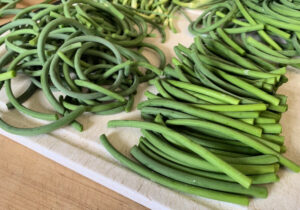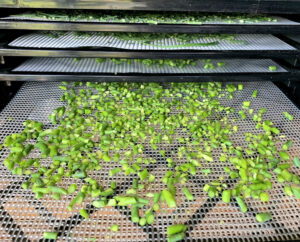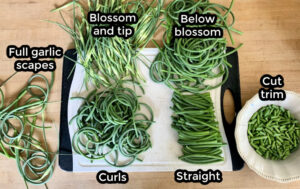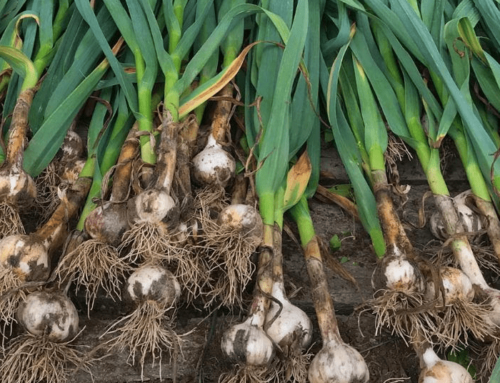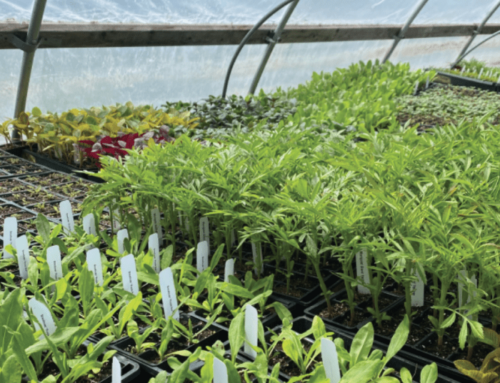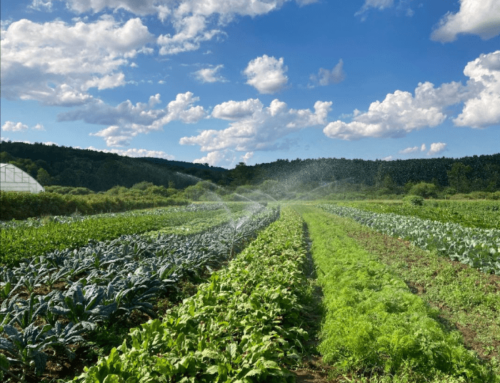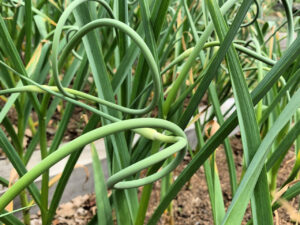
Garlic scapes ready to be harvested
By Christy Bassett, Homesteader at Barefoot All Natural Farm
Garlic scapes come but once per year, but that doesn’t mean that their flavor needs to escape you once the harvest season is over. Here are a few recipes to help you preserve that fresh green garlic for use year-round.
Pickled Garlic Scapes
If you like dilly beans, pickled asparagus, or other tangy vegetables, you’ll love pickled garlic scapes. We eat them straight out of the jar, but they’re also delicious chopped up and added to egg salad or piled up and served on a homemade hot dog.
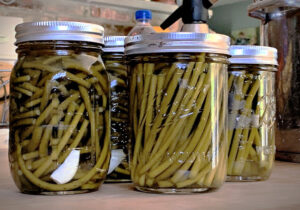
Pickled scapes. (Smaller curls on the left, longer straight sections on the right.)
Ingredients
- 2 large bunches garlic scapes, about 50 stems each
- 4 cups 5% vinegar (apple cider vinegar goes nicely with this recipe, but white vinegar is fine too)
- 4 cups water
- 1/2 cup sea salt
- 4 sprigs dill weed or other herbs
- 8 cloves garlic, split (optional, but adds extra garlic flavor and a couple of bonus pickled garlic cloves at the bottom of the jar!)
You’ll also need: 4 pint jars with lids and bands, large pot or water bath canner, saucepan, water, jar lifter, towel.
Directions
- Prepare your canning jars by boiling them in water in a large pot or water bath canner until sanitized.
- Rinse and trim the garlic scapes, measuring them to the height of the canning jar. I like to use the long, straight sections of the scapes for one neatly packed jar of scape sticks and then stack the shorter, curly pieces in the second jar to use for chopping into recipes later on.
Curly sections on the left, straight sections on the right.
- Place two garlic clove halves in each jar along with any herbs you’d like, then pack your scapes into the jar with them.
- Add vinegar, water and sea salt to a saucepan and bring to a boil.
- Add heated vinegar solution to the prepared jars, leaving ½” headspace. Remove any bubbles that form beneath the surface of the liquid.
- Wipe/dry the rim of the jars, add the lids and bands, and place into the heated water for canning.
- Process/boil prepared jars for 10 minutes, then remove from the water bath with a jar lifter and place on a towel on the counter. Lids will seal as the jars cool.
- Once completely cool, check for full seals and refrigerate any jars that are not fully sealed. (Eat refrigerated non-sealed pickles after 1 week of cure time.)
- Store sealed jars for at least one week before opening, and up to one year for long term preservation.
Green Garlic Powder
You’re probably familiar with the beige colored garlic powder made from garlic cloves. But have you ever tried green garlic powder, made from garlic scapes? It’s a fresh twist on a pantry staple that can be used anytime you’d like to add mild garlicy flavor to a dish.
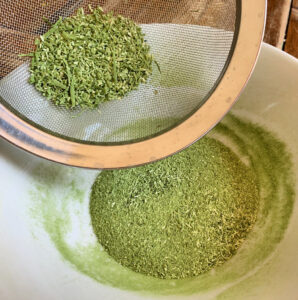
Green garlic powder after being dehydrated and ground, sifting into powder for storage.
Ingredients
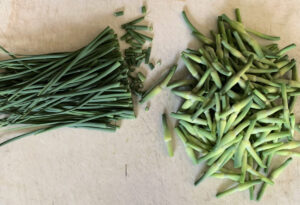
Garlic scape tips with blossom removed.
- Garlic scapes (I like to use the thin tips, from past the blossom, or the bits and pieces left from using the primary part of the scape for other recipes).
You’ll also need: a dehydrator, spice blender or food processor, fine mesh strainer, jar with lid
Directions
- Chop scapes into small pieces that are more or less uniform in thickness, ideally ¼” or less.
- Arrange on the tray of a dehydrator, trying not to overlap pieces.
Chopped garlic scapes on a dehydrator tray.
- Set to the “herb” setting, or 100-100 degrees F, and dry for at least 12 hours, or until crispy and fully dried.
- Blend dried pieces in a spice grinder or other quality food processor until all chunks are pulverized.
- Sift powder through a fine mesh strainer to remove any lingering fibers or bits (optional).
- Store in an air tight jar for up to one year.
Garlic Scape Pesto
I would be remiss if I didn’t mention everyone’s favorite way to enjoy garlic scapes—pesto! Garlic scape pesto is a delicious, flavorful variation on the typical basil pesto many of us are used to. A little goes a long way, so it’s best to freeze this in small portions for use throughout the year.
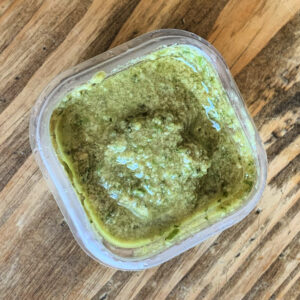
Garlic scape pesto ready for freezing.
Ingredients
- 1 large bunch garlic scapes, about 50 stems
- 1 ½ cups pine nuts, sunflower seeds or walnuts
- 1 ½ cups grated parmesan cheese
- 1 ½ cups olive oil or avocado oil
- Juice of 2 lemons
- Sea salt and pepper to taste
You’ll also need: a food processor, spoon, small jars with lids
Directions
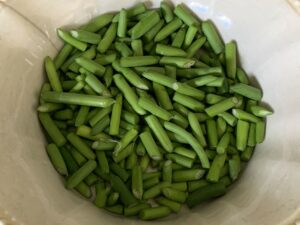
Coarsely chopped scapes.
- Trim scapes to keep the section below the bulb, chop coarsely.
- Add chopped scapes, nuts or seeds, parmesan and lemon juice to food processor. Process until combined.
- Add ½ cup of oil, begin processing again and slowly add the rest of the oil while the food processor is running. Process until all of the oil is incorporated and the mixture is smooth.
- Add salt and pepper to taste and process once more to combine.
- Store in jelly jars in the freezer, or freeze by tablespoon in an ice cube tray and then transfer to an airtight container. Use within one year.
Bonus tip:
All parts of the scape can be used in different ways, so it’s helpful to chop and sort your entire harvest at once before processing.
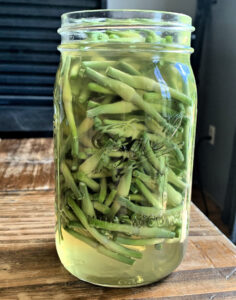
Garlic blossoms infusing in apple cider vinegar.
The only section of the garlic scape that I haven’t used before is the blossom. Some people include this in with their pickle stems, but I prefer the section below the blossom for pickles. This year, I am attempting to infuse the garlic blossoms into apple cider vinegar for use in salad dressings. I hope it turns out to be a delicious, garlicky experiment that helps me to use the whole plant.

